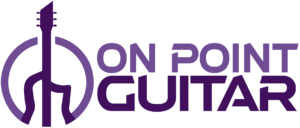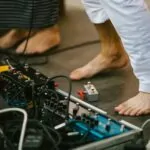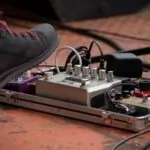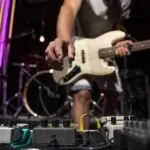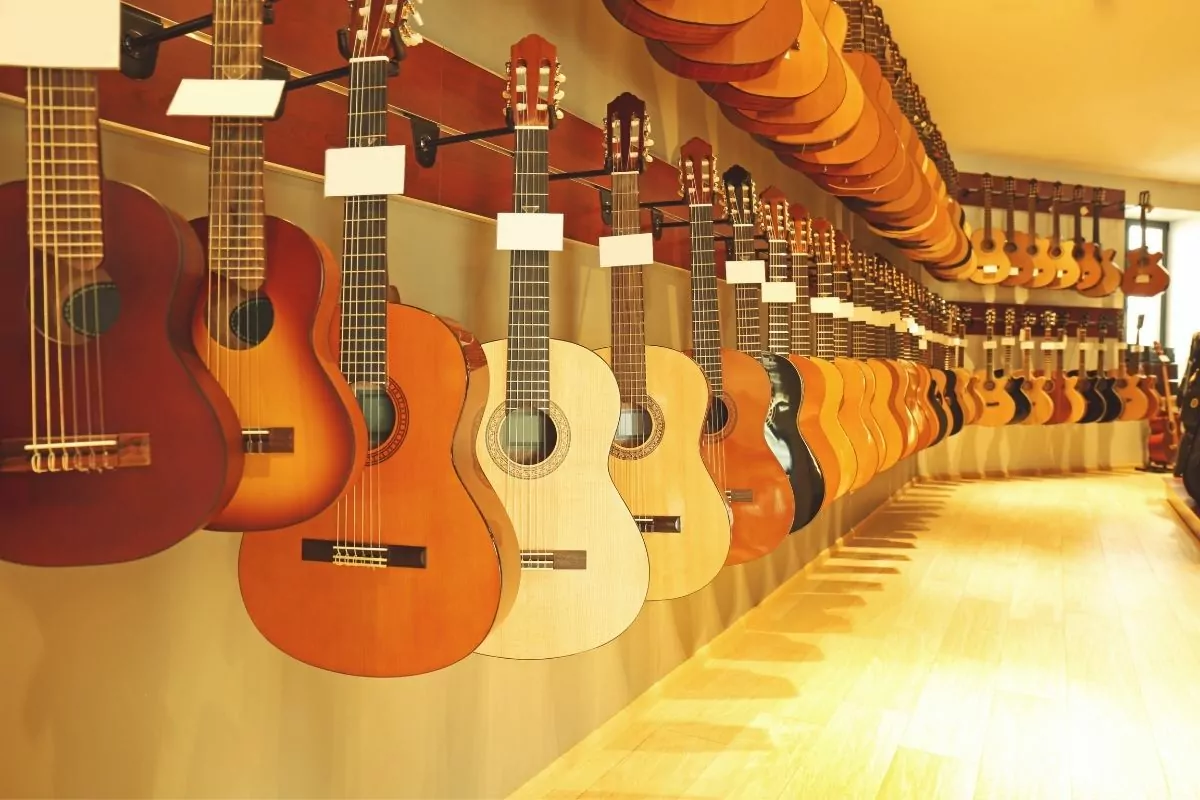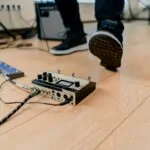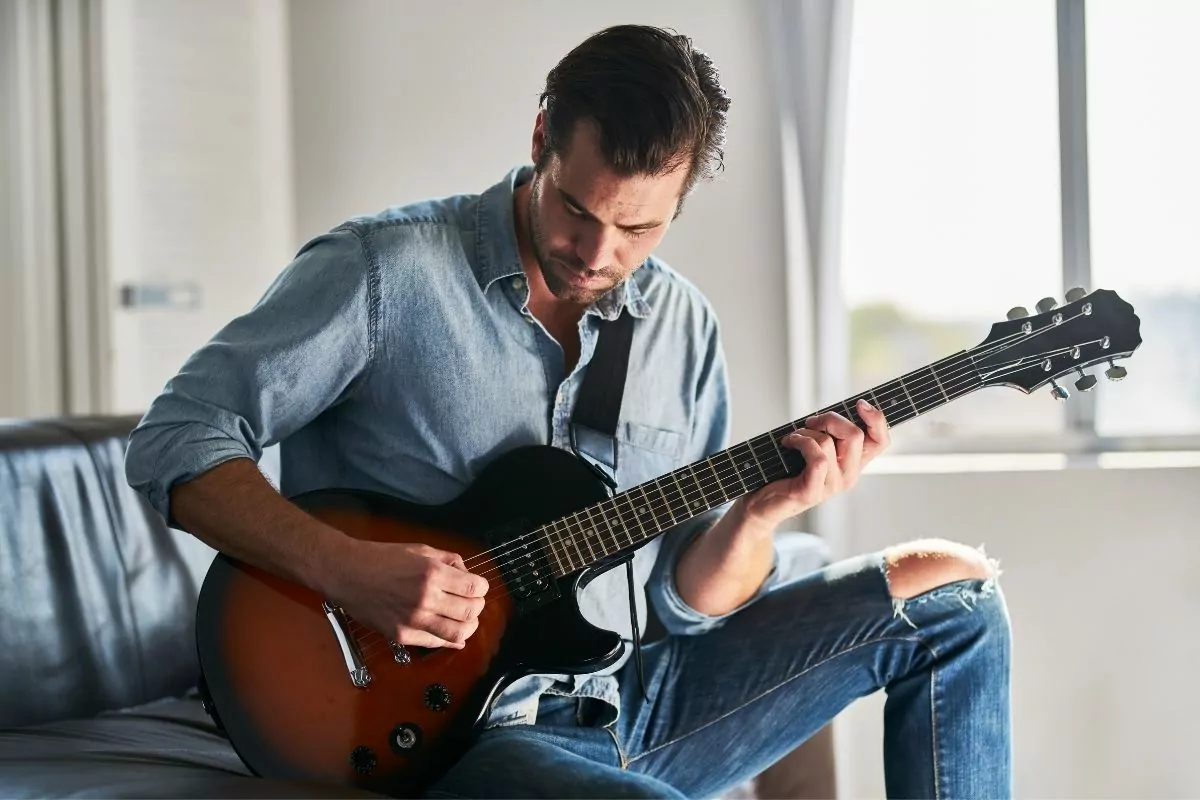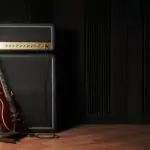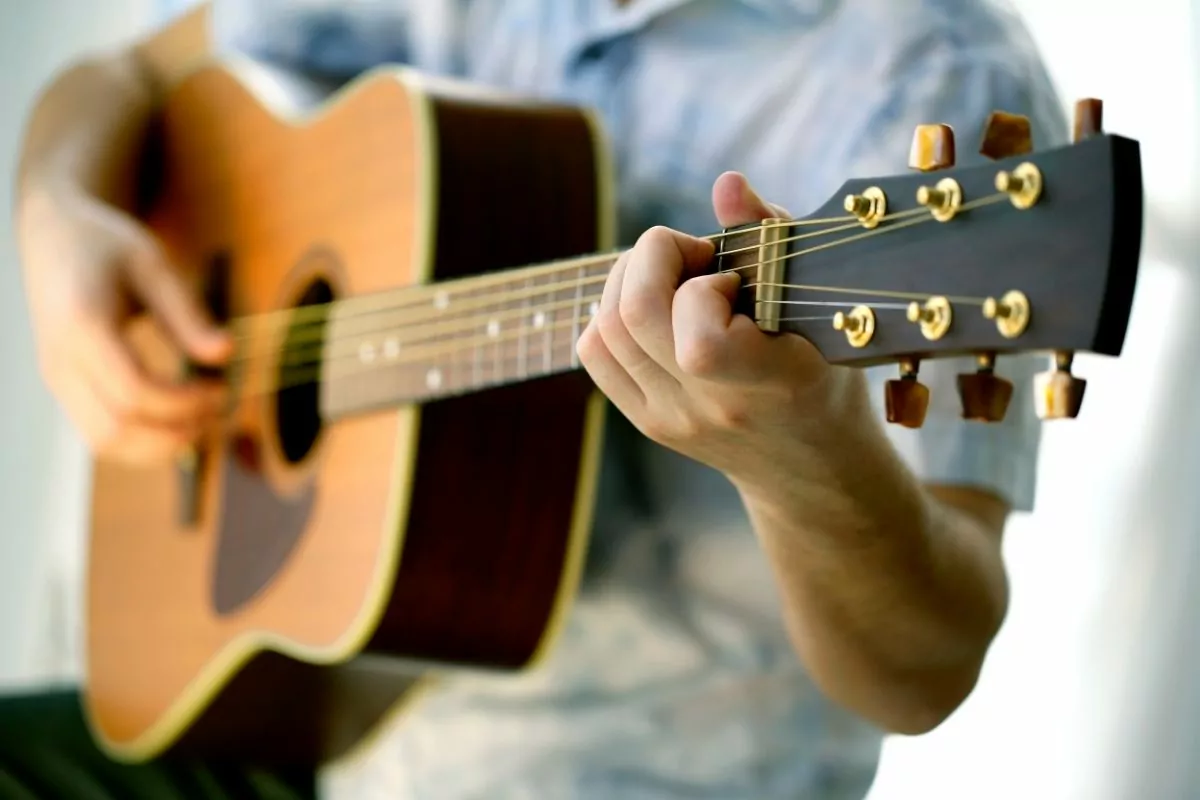Power chords are the most common chord used in rock music, and they’re also one of the easiest to play. Power chords are a type of chord used by electric guitars that include the root, the fifth.
Octaves of those notes are possible too. Power chords are commonly used in conjunction with distortion or overdrive effects, to give rock music a sonic driving force.

Because of how common they are, it can be essential to learn how to play any power chord. In addition, power chords are among the easiest to learn. Mastering a few power chords can boost your confidence in learning how to play the guitar, which is a long and gruelling endeavour.
In this article, we explain what power chords are, their origin, the difference between power chords and chords, and how to play the E power chord guitar.
How To Play E Power Chord Guitar
There are several ways to play the E power chord, depending on which fret you are strumming. The most basic way to learn how to play E power chord on guitar is using the below
- E Power Chord (7th fret) – played from the 7th fret using notes E, B, and E
- E Power Chord (12th fret) – played from the 12th fret using notes E, B, and E
- E Major Power Chord (1st fret) – played from the 1st fret using notes E, B, E, G#
- E Minor Power Chord (1st fret) – played from the 1st fret using notes E, B, E, G
- E Major Power Chord (9th fret) – played from the 9th fret using notes E, G#, B
- E Minor Power Chord (9th fret) – played from the 9th fret using notes E, G, B
- E Major Power Chord (4th fret) – played from the 4th fret using notes E, G#, B
- E Minor Power Chord (4th fret) – played from the 4th fret using notes E, G, B
Origin Of Power Chords
Power chords were first used back when electric blues guitarists Willie Johnsons and Pat Hares recorded songs in the early 50s. It was Pete Townshend who popularized the use of power chords.
He did this by using them in The Who’s song ‘Baba O’Riley’.
The power chord has remained a staple over the past 60 years. If you look at some of the biggest rock hits of all time, you’ll notice that they often feature the same chord progression. Whenever the chord appears, it makes us remember its raw intensity, muscular tonality, and sheer force.
It’s amazing for something that many say doesn’t even qualify as a chord. A chord traditionally consists of three different notes, and when they’ve been playing together, the result is influenced by the three parts. On the other hand…the power chord has less going on.
However, it’s usually accompanied by distortion, which explains why distortion wasn’t used frequently until the mid 20th Century.
Playing these chords back to back would be considered bad form in classical music, but we can understand why composers might have thought of them as lacking strength or flimsiness when playing on the piano or strings.
What Are Power Chords?
A power chord is a two-note chord made up of an open string and a closed string. They are built by starting with a root note and its 5th interval.
These chords are represented using a chord symbol that has a root note followed by a number representing the number of notes in the chord. For example, a D power chord is represented by ‘D5’ and contains the notes D and A (a fifth of D).
The major or minor thirds that give chords their major or minor qualities are not featured in power chords. A power chord has an octave interval of its root note added to it to make it sound fuller and richer.
Power chords are usually used on a guitar with distortion because they’re so common in rock and metal music. However, these chords aren’t limited to these heavy genres either.
Guitar songs show the use of power chords, Reggae shows the use of power chords too. Power chords are versatile and can be used to create different sounds and shapes for your song.
What Is the Difference Between Chords And Power Chords?
A chord can be defined as three notes being played together, simultaneously. Triads are three-note chords that contain these three elements: root, third, and fifth.
Power chords, however, are known as dyads because they solely contain a root and a fifth note. Sometimes, they will also feature an extra octave note, although this isn’t common.
How To Mute Unused Strings?
Try to get your 1st fingernail to lay gently on strings 3, 2 & 1. You don’t wanna hear those notes; you just wanna mute the strings. This will make the chords sound really bad if you allow them to ring out.
You could try to be careful, but that is really difficult. It means that you’ll never be able to rock out and hit the strings with energy or run around on stage like a rock god.
With a super-low action, you may have trouble muting the guitar strings because they will require very little pressure to sound, however, you must. It is the downside of having such low action.
![How To Play Power Chords [3 patterns — endless uses!]](https://onpointguitar.neatandcleanhome.com/wp-content/uploads/2022/04/How-To-Play-Power-Chords-3-patterns-%E2%80%94-endless-uses-1-1024x683.jpg)
You’ll be able to play bar chords easily, but it will take a light touch and a lot of practice to get those strings muted properly.
Often power chords are played with down-strokes only, and sometimes with a technique called palm-muting, which might make it easier to mute the unused strings, but it is really important to mute them because a lot of songs do use up-and down strokes with power chords (“Smells Like Teen Spirit” springs to mind).
Also if you don’t mute the strings, and you play loud without distortion, the strings might still ring out even if you didn’t pick them, and this will make your chords sound muddy. So make sure you sort out your string muting now!
Two Common Power Chord Patterns
Thankfully, playing power chords isn’t rocket science, but that doesn’t mean they don’t require hours of practice either. Once you learn these two super-common power chord patterns you should be able to string a simple rock song together. power chord patterns, in general, use the same pattern, just with different fingers.
One cool thing about power chords is that they can be put to use across the whole fretboard of your guitar. Unlike other chords which can’t be shifted to different frets, power chords hold their same pattern no matter where they are placed on the fretboard, giving you the freedom to experiment.
Power Chord Pattern 1
To kick things off, let’s start with a nice and easy power chord.
- Begin with your index finger placed on the 5th fret of the low E string.
- Then place your ring finger on the 7th fret of the A string.
- Once you’ve done that it’s time to strum, making sure it’s just the low E and A string.
There you have it, you’ve just played your first power chord. Feels pretty killer doesn’t it?
Power Chord Pattern 2
Pattern two is slightly more challenging. However, after your strumming success of the first pattern, you’ve got this.
All you have to do is start with your fingers in the same position, but with the addition of another finger.
- Place your index finger on the fifth fret of the E string.
- Your ring finger is up next, and it needs to be placed on the A string’s seventh fret.
- It may be a little tough at first, but try to tuck your pinky finger up onto the D string’s seventh fret. This note is now classed as the octave of your index finger’s note.
- Now strum, strum, strum until it becomes finger-muscle memory.
As you may have heard, the octave of this power chord has given it an extra kick of juice for a noticeably fuller sound.
Conclusion
As you can see, e power chord guitar are a solid foundation from which many rock songs are built. Super simple to play, and offering guitar players plenty of impact on stage, it’s little wonder why the rock gods of the past, present, and undoubtedly the future keep turning to power chords for, well, power.
So whether you’re just starting out on your journey of playing guitar, or you’re touching up your power chord knowledge to hopefully write a song or two. We hope this article has been a helping hand in getting you there.

My name is Howard Matthews and I have been playing the guitar since I was knee-high. My parents like to joke that I was pulling the strings even before I was born. In fact, one of my earliest memories is sitting on the couch with my dad’s guitar, wreaking havoc on the chords.
Now, 40 years later, I can attest that I play them much better than I did back then. I have followed in the footsteps of both my parents – much to their delight – and have been the main guitarist in my band for the best part of three decades.
Music has always been my passion, and until recently my life has been so consumed with it that I haven’t had a moment to have a breath (and I wouldn’t have it any other way)!
